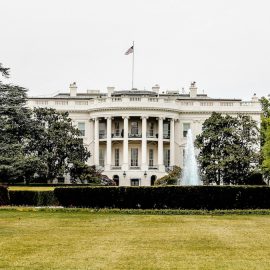

This article is an excerpt from the Shortform book guide to "Grant" by Ron Chernow. Shortform has the world's best summaries and analyses of books you should be reading.
Like this article? Sign up for a free trial here.
What did Ulysses S. Grant do during the Reconstruction Era? How did he try to reconcile the North and the South of the United States?
In Grant, Ron Chernow argues that Grant’s presidency was marked by attempts at international and domestic conciliation. However, these attempts weren’t always successful.
Let’s look at Ulysses S. Grant’s reconstruction attempts.
International Conciliation With Great Britain
During an era of Reconstruction, Ulysses S. Grant successfully alleviated post-war tensions with Great Britain by savvily navigating the so-called Alabama claims. These claims, he points out, arose during the Civil War, in which five warships constructed in Great Britain—most famously the CSS Alabama—were used by the Confederacy to fight the Union despite Britain’s alleged stance of neutrality. After the Civil War, Northern politicians demanded compensation for damages wrought by the warships, with Senator Charles Sumner proposing a radical $2 billion dollar settlement.
(Shortform note: Historians note that, to maintain the appearance of neutrality, Great Britain built these warships under the pretense that they were mere trading vessels. By the end of the Civil War, however, the Alabama alone had captured 58 of the North’s crucial commerce ships, and along with the four other British warships (the Florida, Georgia, Rappahannock, and Shenandoah) had sunk around 150 Union ships.)
As Chernow relates, Grant handled the situation masterfully: Through his secretary of state, Hamilton Fish, he established an international committee composed of American and British members to arbitrate the Alabama claims. As a result of this arbitration, Britain admitted fault and agreed to a $15.5 million settlement. In Chernow’s assessment, Grant won the admiration of the American public by getting Britain to admit culpability, but he also avoided confrontation with Great Britain by allowing an international tribunal to arbitrate the claims. He thus tactfully resolved a situation that could have resulted in domestic upheaval or international conflict, setting the stage for peaceful international arbitration in the future.
(Shortform note: Although Grant wasn’t always the best judge of character (as we’ll discuss later), his appointment of Fish was one of the successes of his Presidency. Besides the Alabama claims, Fish presided over several other important negotiations, such as when he avoided war between the US and Spain after the Spanish government in Cuba executed a number of US citizens for piracy. In 1981, a poll of US historians ranked Fish as the US’s third-greatest Secretary of State to that point.)
Attempted Domestic Conciliation With the South
Despite Grant’s success in international diplomacy, he was unable to attain similar success domestically. According to Chernow, Grant consistently sought to reconcile the North and the South post war, but failed to do so.
Grant’s goal of reconciliation, Chernow points out, was evident before he took office—as lieutenant general post-Civil War, Grant threatened to resign when President Andrew Johnson declared his intent to prosecute Lee and other Confederate leaders for treason. Grant understood that prosecuting Lee would not only violate the Appomattox surrender agreement, but it would also incite further unrest in the South. Not wanting to oppose Grant, President Johnson decided to avoid prosecuting the Confederate leaders.
(Shortform note: In The Lost Indictment of Robert E. Lee, John Reeves examines how Lee was able to evade an indictment in Virginia and even enjoy a comfortable post-war life as the president of Washington and Lee University. He argues that, in the name of reconciliation, Lee’s indictment was largely overlooked during his life and forgotten in subsequent decades, hence why Lee has become almost a folk hero in certain regions of the South today.)
Nonetheless, Chernow argues that by the end of Grant’s presidency, the divide between North and South was irreconcilable. He alleges that Grant’s aggressive strategy to defeat the KKK—which involved consistently stationing federal troops in Southern states—led Democratic Congressmen to regain control of Southern states, which viewed the presence of federal troops as an attack against states’ freedoms. As leaders of the South, these Democrats cast the Civil War as an act of “northern aggression” and an assault on states’ rights, downplaying the role slavery had played in causing the war. According to Chernow, this increased Democratic control of the South led to the end of Grant’s Reconstruction era in 1877.
(Shortform note: The pervasive view among Southern Democrats that the Civil War was primarily an affront against states’ rights remains prevalent today. According to a 2011 Pew Research Center poll, 48% of Americans believe the war was mainly about states’ rights, whereas 38% of Americans believe it was mainly about slavery. However, those proportions might be changing, as a 2015 poll found that 53% of Americans believed slavery was the cause of the war, while 41% disagreed).

———End of Preview———
Like what you just read? Read the rest of the world's best book summary and analysis of Ron Chernow's "Grant" at Shortform.
Here's what you'll find in our full Grant summary:
- A biography of Ulysses S. Grant that paints him in a new light
- Grant's role in the Civil War and as president of the United States
- How Grant fought valiantly against alcohol addiction






